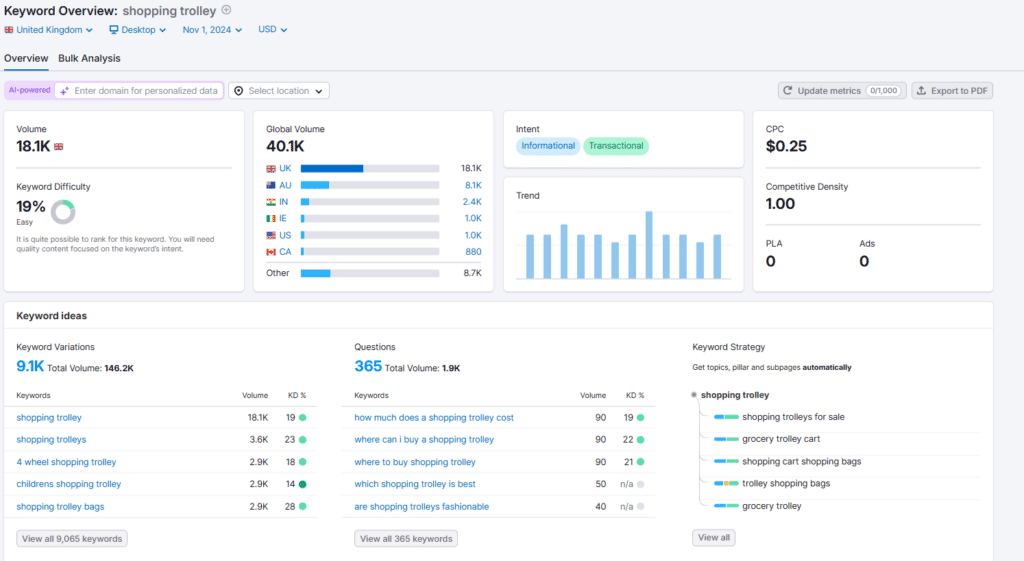
In the last post, we talked about international SEO strategies and expanding your global reach. One of the steps to do this is conducting extensive international keyword research. That is, keyword research from a global standpoint.
As I’ve said numerous times, understanding what your target audience is searching for in their native language is the cornerstone of any successful international SEO strategy. Simply translating keywords from one language to another often misses the mark. It doesn’t account for local search behaviors, cultural nuances, or regional slang.
The TLDR version? Conducting specific keyword research for each country ensures you’re optimizing your international site for the terms people actually use in their Google searches.
Recognize That Keywords Vary by Region
In the realm of international markets, user intent and search habits can vary dramatically. A keyword that ranks highly in one country might be irrelevant in another. For instance, while “boot” refers to footwear in the U.S., it means the trunk of a car in the UK.
Without proper international keyword research, you risk optimizing for the wrong terms. In turn, this can lead to low organic traffic and poor engagement from your international audience.
Steps to Effective International Keyword Research
So what does this research look like, and how do we do it? In the previous post, I gave bullet points. Here’s the in depth process:
1. Leverage Local Keyword Tools
Begin by using keyword research tools that allow you to set parameters for different countries and languages. Google’s Keyword Planner, SEMrush, and Ahrefs all offer options to specify the specific country and language. This functionality provides more accurate data on relevant keywords for your target market. IT helps you identify search volumes, competition levels, and keyword variations used by native speakers.
Action Step: Set up accounts on these tools and adjust the settings to your target market. Note down high-volume keywords that are relevant to your product or service.
Which countries are bringing traffic for which terms? You don’t have to guess:

To conduct international keyword research using SEMRush for a target country, follow these steps:
- Go to the ‘Keyword Overview’ Tool:
- In the left-hand menu, under the “Keyword Research” section, select “Keyword Overview.”
- Enter Your Target Keyword:
- Type in a relevant keyword or phrase that you think may be popular in the target country. This will be your starting point for gathering data.
- Select the Target Country:
- Directly under the search bar, there’s a dropdown menu Click on it and select the country you’re targeting (e.g., “United Kingdom,” “Germany,” etc.). This setting will help SEMRush pull data relevant to the chosen region.
- Analyze Keyword Data:
- Once you’ve set the country and clicked “Search,” SEMRush will provide insights, including monthly search volume, keyword difficulty, related keywords, and search intent. Review these metrics to gauge the keyword’s potential in your target market.

- Explore Related Keywords:
- Scroll down to “Keyword Variations,” “Questions,” and “Keyword Strategy” sections to find variations of your initial term that local users might be using. SEMRush also provides “Questions” and “Keyword Variations” sections, showing how users phrase their queries differently. Select high-relevance, high-volume keywords from these lists for further consideration. This area is helpful for uncovering region-specific slang or culturally relevant terms, as well.
- Check Competitor Keywords:
- Go to the “Organic Research” tool and enter the domain of a local competitor in your target market. This will reveal keywords they’re ranking for, allowing you to spot opportunities or gaps.

- Compile Your Target Keywords:
- Collect the high-volume and relevant keywords discovered from each step. You can add them to SEMRush’s “Keyword Manager” for tracking and exporting.
- Monitor Performance:
- As you integrate these keywords into your content, monitor their performance over time in SEMRush’s “Position Tracking” tool. Adjust your strategy based on trends and emerging keywords for the target country.
Using SEMRush in this way helps ensure that your SEO strategy aligns with local search behavior, boosting engagement and relevance for international users.
2. Understand Cultural and Linguistic Nuances
Language is deeply tied to culture. Slang, idioms, and colloquial expressions can significantly impact which keywords are effective. For example, a term that’s popular in Spain may not be commonly used in Mexico, even though both countries speak Spanish. Engaging with native speakers or hiring local SEO experts can provide insights into these nuances, ensuring your content resonates with the target audience.
Action Step: Consider collaborating with local linguists or SEO services that specialize in your target market. They can help you understand subtle differences and preferences in language use.
3. Analyze Local Competitors
Look at what’s working for competitors in your target market. Use SEO tools, like the SEMRush walkthrough above, to examine which keywords they rank for and how they structure their content. This can reveal gaps in the market or opportunities where you can outperform them. Pay attention to their URL structures, meta tags, and headings, as these can offer clues about successful strategies in that region.
Action Step: Make a list of top competitors in each specific country. Use tools like Ahrefs or SEMrush to analyze their keyword profiles and identify opportunities for your own site.
4. Consider Search Intent
Understanding the intent behind Google searches is crucial. Are users looking for information, ready to make a purchase, or seeking specific services? Aligning your international keyword research with user intent improves the relevance of your content, leading to higher engagement and conversion rates. For instance, informational keywords might include “how to” or “best ways to,” while transactional keywords could be “buy,” “discount,” or “price of.”
Action Step: Categorize your keywords based on user intent. Tailor your content to meet these specific intents. SEMRush is also a tool to help you easily identify user intent. In the Intent column, you’ll see (I)nformational, (T)ransactional, (C)ommercial or (N)avigational, as well as how difficult it might be to achieve ranking for the term (KD%).

5. Avoid Direct Translations
Translating keywords directly from one language to another can result in awkward or nonsensical phrases. Instead, focus on finding the equivalent terms that native speakers actually use. This might involve adjusting your keyword strategy entirely for each language or region. Professional translators with SEO experience can be invaluable in this process.
A real-life example of direct translation causing issues is when Parker Pen tried to enter the Mexican market. The company wanted to promote their pens as reliable. They said in English, “It won’t leak in your pocket and embarrass you.”
However, when they translated this message directly into Spanish, that’s not what it said. Instead, it read, “No te embarazará,” which means “It won’t make you pregnant” in Spanish. This mistranslation not only led to confusion but also missed the mark entirely for Mexican consumers.
This example highlights why direct translation doesn’t work in marketing. Cultural nuances, slang, and regional expressions often require localization to make sure that a brand’s message resonates appropriately with the audience. Translating keywords or phrases without understanding local context can result in messaging that is ineffective or even counterproductive, impacting brand perception and customer trust.
Action Step: Invest in professional translation services or work with bilingual SEO experts who understand both the language and SEO best practices.
6. Use Long-Tail, Low-Volume, and Zero-Volume Keywords
Relying on short, generic keywords might seem appealing, but targeting specific terms is often much more effective. Think of searching for “Band-Aid” and sifting through a flood of results—finding what you need in such a broad search can be overwhelming. Instead, focus on long-tail, low-volume, and zero-volume keywords to reach users with intent.
- Long-Tail Keywords: These are longer, more specific phrases (e.g., “best waterproof Band-Aid for swimming”). Users users typically search these when they’re closer to making a purchase or using voice search. In international SEO, long-tail keywords help capture niche markets and lower competition, and they often have higher conversion rates as they closely align with what users are looking for.
- Low-Volume Keywords: While these may have fewer searches, low-volume keywords (e.g., “eco-friendly Band-Aid alternative”) attract a smaller, more targeted audience who may be highly interested in your offering. These keywords help fill market gaps and connect with specialized user segments.
- Zero-Volume Keywords: Surprisingly valuable, zero-volume keywords can uncover new trends or connect with unique customer needs. Often, these phrases capture rare queries or emerging terminology, letting you stand out to those searching in less saturated areas.
Why These Variations Work: Targeting long-tail, low-volume, and zero-volume keywords helps you rank for niche terms that larger competitors often overlook. This approach also aligns your content more precisely with user intent, leading to better engagement, higher conversion rates, and stronger connections in each target market.
Action Step: Identify and incorporate long-tail, low-volume, and zero-volume keywords relevant to each target market. Craft your content around these terms to capture highly targeted organic traffic and connect with intent-driven users.
7. Incorporate Regional Variations
Even within the same language, regional differences can affect keyword usage. For example, English keywords in the UK differ from those in Australia or Canada. Be mindful of these differences when conducting international keyword research for multiple countries. This attention to detail enhances your SEO strategy and ensures you’re connecting with each segment of your global audience effectively.
Action Step: Create separate keyword lists for each region, even if they share the same language. Adjust your content accordingly to reflect these regional preferences.
A great example of regional keyword variations is the difference in terms for “sneakers” between the U.S. and the U.K.
In the United States, “sneakers” is the preferred term for athletic shoes. In the United Kingdom, the same type of footwear is more commonly called “trainers.” If a brand targets both U.S. and U.K. audiences but only optimizes for the term “sneakers,” they may miss out on searches from U.K. users who are primarily searching for “trainers.”
Another example is the difference between “apartment” in the U.S. and “flat” in the U.K. For an international real estate platform or a rental website, using both “apartment” and “flat” (based on region) ensures they connect with users in each country more effectively.
These regional variations matter because they reflect local language habits, and optimizing for the correct terms helps search engines connect your content with the right audience in each region.
- Google Trends: Analyze the popularity of search terms across different regions and languages. This tool helps you understand seasonal trends and emerging keywords in your target market.
- SEMrush and Ahrefs: Use their international databases to find keyword opportunities and analyze competitor keywords. They offer insights into keyword difficulty, search volume, and SERP features for different countries.
- Baidu Keyword Planner: If targeting China, Baidu is the dominant search engine, and their keyword planner is essential. It provides data specific to the Chinese market.
- Yandex Wordstat: For Russia and Russian-speaking markets, Yandex provides valuable keyword data. This tool helps you tailor your SEO strategy to Russian users.
- Local Forums and Social Media: Explore popular forums, social media platforms, and community sites in your target market to understand common language and topics of interest. This qualitative data can uncover keywords and phrases not found in traditional tools.
Action Step: Compile a list of these tools and incorporate them into your regular SEO workflow. Regularly update your keyword lists based on new data and trends.
Collaborate with Local Experts
Partnering with local SEO agencies or consultants who offer international SEO services can greatly enhance your keyword research efforts. These experts understand the local landscape and can provide insights that are difficult to obtain otherwise. They can assist in identifying high-performing keywords, cultural sensitivities, and compliance with local regulations.
Action Step: Research and reach out to reputable local SEO professionals in your target markets. Establish partnerships to leverage their expertise for your international campaigns.
I firmly believe our local SEO partnerships around the world is one of the reasons for the success of many of our international clients. By having “boots on the ground,” so to speak, we have access to the exact language of our clients’ target market. This access greatly improves a businesses ability to integrate into a new region.
Integrate Keywords Naturally into Content
You know this. Or you should, if you read our blogs regularly. We’ve been tooting the horn for natural, crunchy-granola, earthy SEO since 1909 (well, for a long time, anyway). What good is SEO optimization if your SEO keywords are obviously SEO’d and beat the reader down with all that SEO content?
Save all your research. Make it count by incorporating keywords into your content in a way that feels natural to native speakers. Keyword stuffing or awkward phrasing can deter readers and harm your search rankings. Focus on creating high-quality content that provides value to your international audience, with keywords seamlessly integrated.
Action Step: Review your content to ensure it reads naturally. Consider having a native speaker proofread your content to catch any awkward phrases or errors.
Monitor and Adjust Your Keyword Strategy
The effectiveness of keywords can change over time due to trends, seasonality, or shifts in user behavior. Regularly monitor your keyword rankings and traffic patterns in each international market. Use analytics to assess which keywords are driving traffic and conversions, and adjust your strategy accordingly.
Action Step: Set up regular reports in Google Analytics and your SEO tools to track performance. Be prepared to refine your keyword lists and content strategy based on this data.
Case Study: Success Through Targeted Keyword Research
A well-known case study that highlights the success of targeted international keyword research is Airbnb’s expansion strategy. When Airbnb entered new markets globally, they didn’t just translate their existing keywords. Instead, they conducted in-depth keyword research to understand how people searched for accommodations in each region.
For example, in Japan, Airbnb discovered that people were often searching for “cheap apartments” or “short-term rentals,” rather than general terms like “vacation rental” or “holiday accommodation.” In France, terms like “location vacances” (holiday rentals) were much more popular.
By tailoring their keyword strategy to these regional preferences and search habits, Airbnb optimized its content and ads for the specific language and search terms used in each target country. This approach ensured they appeared at the top of search results for highly relevant, intent-driven keywords in each region.
The result was a significant boost in organic traffic and conversions from international markets. Airbnb’s success through localized SEO and targeted keyword research illustrates how understanding regional language and search behavior can vastly improve user engagement and drive business growth globally.
Wrapping it up
In today’s globalized world, effective international keyword research isn’t just a translation exercise. Words connect audiences through culturally and regionally relevant language. By understanding local search behavior, leveraging the right tools, and integrating keywords naturally, you can maximize your reach in new markets. The power of keywords lies in their ability to align your business with user intent and resonate with your audience, no matter where they’re located.
Ready to expand your global reach?
Let Level343’s international SEO experts help you optimize for success in new markets. Contact us today to build a keyword strategy that speaks to your audience in every language and region.



